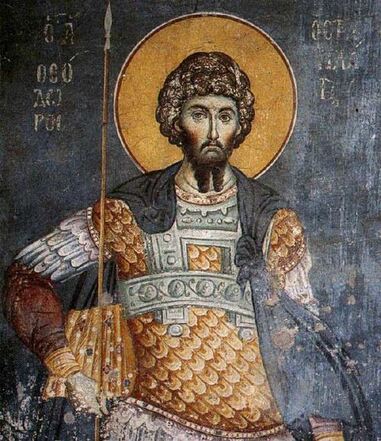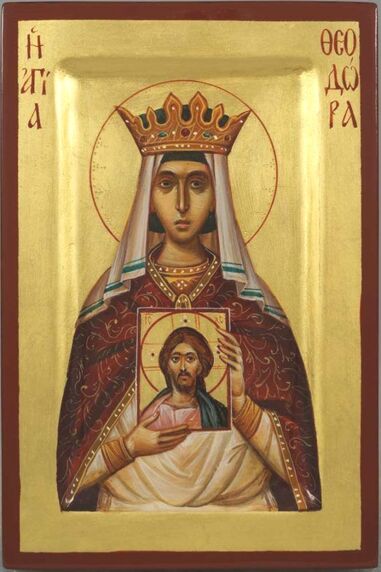st theodore of tyro and sunday of orthodoxy  ST THEODORE OF TYRO - THE RECRUIT Each year on the first Saturday of Great Lent, our Holy Church commemorates St Theodore the Recruit. According to the time-honoured tradition, this feast is dedicated to St Theodore of Tyro, known as St Theodore the Recruit, and to his miraculous appearance to Eudoxius, archbishop of Constantinople, during the reign of emperor Julian the Apostate (332-363). The story involving this miracle is well known. Emperor Julian was called the Apostate because during his rule as Caesar (355-361) and then Augustus (361-363) he attempted to restore the pagan cults and to eradicate Christianity. To fulfill this aim, he enacted a range of legal measures, including the persecution of Christians. The Emperor was known for his mocking attitude towards Christianity, which is clearly evident in the few written works of his that have been preserved — most notably in his satires "The Caesars" and "Misopogon," as well as in the remaining fragments of "Against the Galileans." By "Galileans" he means the Christians. Christ Himself he mockingly called "the Galilean," and the Christian churches "ossuaries," due to their possession of Holy Relics. As part of his campaign against the Christians, during Great Lent he decided to mock them by secretly commanding that all Lenten food at the market was to be sprinkled with blood from pagan-sacrificed animals. His aim was to then announce all Christians as pagans, regardless of the fact that they had eaten these foods without knowing of his deed. Through God's gracious providence, however, says the agiographer, St Theodore sensed this plan. He warned Eudoxius, the archbishop of Constantinople, who took action, as a result of which the Emperor's plan failed. In remembrance of this event and in thanks to God's intervention through St Theodore, the Church has ordained that on the first Saturday of Great Lent the miracle performed by the Saint is to be commemorated. The Christians bless specially cooked wheat - “kolivo” - in commemoration of the “miracle with the kolivo”: in order to prevent Christians from eating food which was sprinkled with idolatry blood, St Theodore told the archbishop to tell all Christians to eat boiled wheat with honey for a week. Apart from this, the memory of St Theodore is celebrated on the 17th of February, on the day of his martyrdom. St Theodore was a Roman soldier who was imprisoned - hence the name "the Recruit" - after being accused for arson attack on a Roman temple, and martyred after he confessed his Christian faith by being thrown into fire. www.oca.org/saints/lives/2021/02/17/100547-greatmartyr-theodore-the-tyro-the-recruit The Saturday of St Theodore was established as a feast by the holy Empress Theodora II (842-856). It was ordained that it was to be celebrated directly before the Sunday of Orthodoxy, so as to also commemorate the deed of the Empress, who was the wife of the iconoclast emperor Theophilus and the mother of Emperor Michael III, thanks to whom the icon-worship was restored. Not coincidentally is the Sunday of Orthodoxy celebrated the next day: a commemoration of all those who have fought for the sanctity and fullness of Orthodoxy.” Written by Ventzislav Karavaltchev Translated into English by Daniil Gerov sunday of orthodoxy  "Let us clap our hands for joy seeing this great blessing that we have received, how the divided members of Christ have been brought to unity! Let us praise the God Who has bestowed peace upon us! - Today the Church is given the festival of victory through the divinely-inspired order and will of our gracious emperors Michael and Theodora who in piety uphold the true Faith. - The sword of heresies has failed and we experience a holy joy, O spotless Virgin, as we see your whole Temple reverently adorned with the holy icons. - Let the mystical trumpets of Christ's Apostles sound forth in harmony, proclaiming the restoration of the holy icons. - Depicting Thy divine form in the icons, O Christ, we openly sing of Thy Nativity, Thine ineffable miracles and Thine voluntary Crucifixion. - The icons of the prophets, apostles and martyrs, the images of all the saints, adorn the heavenly Jerusalem which shines with spiritual beauty of the Bridegroom and the unwedded Bride." (From the Canon and the Sessional hymns of the Sunday of Orthodoxy - the First Sunday of Great Lent) Edited and compiled by Vera Davidova-Pote
0 Comments
Leave a Reply. |
Parish Blog
This mainly contains homilies and messages from our priests, although there is some scope to share thoughts and interesting articles which we may want to share with others Archives
October 2022
Categories |
 RSS Feed
RSS Feed